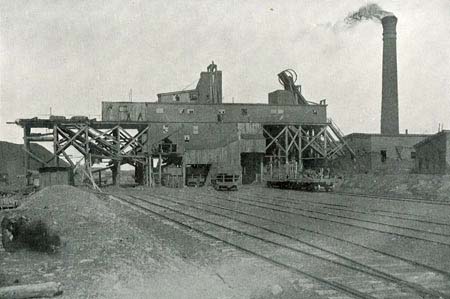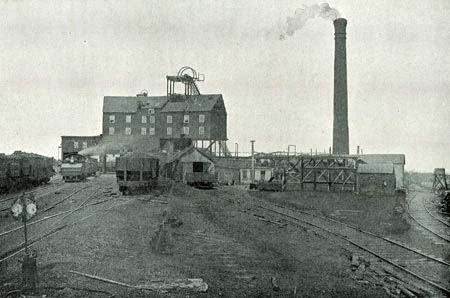The Dominion Coal Company
This Company controls the whole of the land area of the Glace Bay and Lingan-Victoria basins, together with the adjacent submarine areas, which
are for all practical purposes unlimited. It controls also the greater part of the land and submarine areas in the Morien basin, some extremely
valuable submarine areas in the Sydney Mines basin, and has, in addition, a number of detached areas scattered throughout the Island of Cape
Breton in advantageous positions. In addition to the Cape Breton properties, this Company controls and operates the Springhill Mines in Cumberland
county, on the mainland of Nova Scotia, and the areas of the Cumberland Railway & Coal Company in the Morien basin, Cape Breton.
The Company has in full operation 17 collieries: 15 in Cape Breton, and 2 at Springhill.

The International Colliery - circa 1903 Photographer unknown - NSARM Library F108V59.
No. 17 Colliery is the Old Victoria mine, which was closed down in 1897, then un-watered and rehabilitated in 1913. This mine was not working
in 1916, owing to the shortage of miners, but it is sufficiently developed to produce up to 800 tons per day, whenever conditions will permit of
its operation.
No. 3 Colliery was worked out and closed down in 1915. This mine was opened in 1899, and in its lifetime produced approximately four million
tons of coal.
No. 8 Colliery was worked out and abandoned in 1914. The mine was opened in 1863, and in its long lifetime produced 5,400,000 tons of coal.

The Caledonia Colliery - Circa 1903 Photographer unknown - NSARM Library F108V59.
The most valuable seam in the Glace Bay basin is the Phalen seam, which for this reason, has been most extensively worked. The land area is
largely exhausted, one of the land mines, No. 3, as previously mentioned, having been closed down, and another, No. 5, is approaching exhaustion.
The whole land area of the Phalen seam is underlaid by the Emery seam at a depth of about 160 feet. The workings of No. 10 Colliery on the Emery
seam are situated beneath those of No. 5 Colliery mining the Phalen seam, and those of No. 11 Colliery are extracting the Emery seam where it lies
under the exhausted Phalen workings of No. 3 Colliery. In both cases the plant and houses erected in connection with the Phalen seam are being
utilized for the Emery seam, and the same procedure is possible, and will no doubt eventually be followed in the case of Mines Nos. 1, 2, 4, and
6, now operating on the Phalen seam, whenever the time for this shall arrive.
Underneath the Emery seam there are known to be at least three workable seams of good quality, none of which have been more than touched by
crop openings, so that the potentialities of the land area are very great. In the submarine tracts all the seams are present, and have been so
little worked that they may be properly regarded as virgin areas, with the possible exception of the workings on the Hub seam, the topmost seam of
the series.
The output capacity of the mines now being operated by the Dominion Coal Company, on single shift, and exclusive of the Springhill Collieries,
and allowing for the usual winter conditions is 5 1/4 million tons per year. This tonnage can of course be increased to any desired quantity by
the development of new collieries.
The Dominion Coal Company owns and operates the Sydney & Louisburg railway in Cape Breton, and the Cumberland railway in Cape Breton
county. It has extensive machine shops, locomotive repair shops, foundries, and coal washers, etc. It owns a chain of retail stores for the sale
of goods to workmen, and has found it necessary to provide very extensive housing accommodation for its workpeople.
In addition to the property at the mines and the loading ports of Sydney, Louisburg, Glace Bay, and Morien, the Company owns extensive modern
discharging plants at Montreal and Three Rivers, Quebec, Halifax, Nova Scotia, and Saint John, New Brunswick.
The geographical position of the mines, the climatic conditions, and other special features of the industry, have combined to make the Dominion
Coal Company almost as much a transportation company as a coal mining concern, and a larger expenditure has been necessary on transportation
facilities than is usual in coal mining operations.
The Dominion Coal Company is a main subsidiary of the Dominion Steel Corporation, hence a large portion of the output of the mines is used in
the works of the Dominion Iron & Steel Company at Sydney, where 650 by-product coke ovens are usually in full operation.
The employees number over 13,000 persons, and approximately 12,000 persons, workmen of the Company and their families, are housed at the mines,
in dwellings erected and owned by the Company.
History of Coal Mining in Nova Scotia by Gary W. Ellerbrok.

|